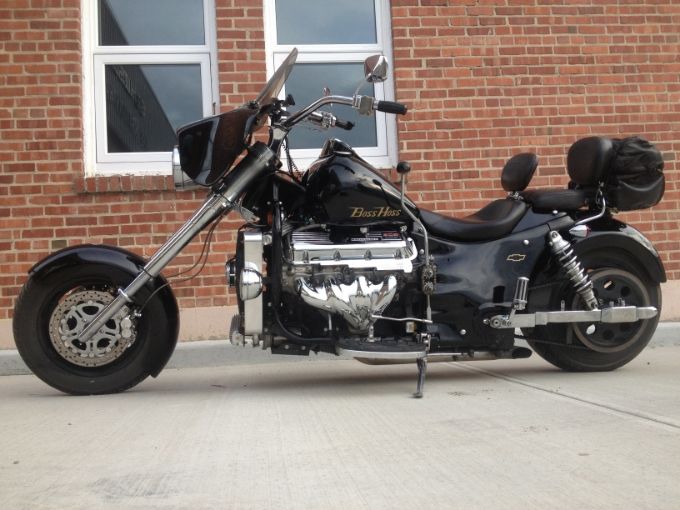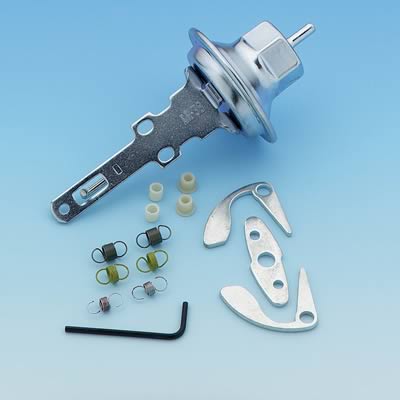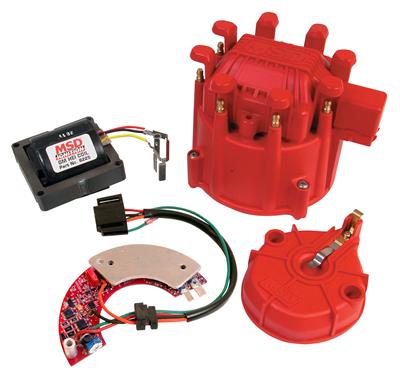Carburetor Vacuum Ports:
Manifold, Ported and Venturi Vacuum Explained
by Lars Grimsrud
Colorado Corvette Crazies
The Ultimate Corvette Tuning and Beer Drinking Fraternity
Lafayette, CO Rev. New 9-10-03
This tech paper will discuss the concepts of 3 different types of vacuum sources, and will briefly discuss
their potential uses and applications in tuning GM V8 engines.
Overview
The airflow through a carburetor and through an engines intake system creates various pressure regions
due to a variety of effects. The low pressure regions are sources for vacuum used for signal sources and
power sources for operating accessories.
Vacuum in an engine is not truly a vacuum. Rather it defines a lower-than-atmospheric-pressure area
in the engine or in the carburetor. Lower-than-atmospheric pressure is measured in inches of Mercury.
Mercury has the chemical symbol Hg, so the terminology for the measurement becomes in. Hg. To
visualize how this measurement works, imagine a U-shaped glass tube partially filled with Mercury. The
one end of the tube is exposed to the atmosphere. The other end of the tube is attached to your low
pressure source. The low pressure on the one end of the tube will cause the Mercury to rise up the tube.
The amount that it rises is in. Hg.
A funny terminology issue arises with this: Most people would describe that the low pressure area is
sucking the Mercury up the U-shaped tube. To be technically correct, there is no such thing as suction.
What is actually happening is that the low-pressure area is allowing the high pressure on the other end to
push the Mercury up the tube. Thus, when you suck on a straw in a milkshake, you are not sucking:
You are creating a low pressure region in your mouth, and atmospheric pressure is pushing the milkshake
up the straw and into your mouth.
How Vacuum is Produced
In an engine and carburetor there are two different mechanisms (processes) for producing vacuum. The
two are interesting in their differences.
The most commonly recognized vacuum source in an engine is manifold vacuum. Manifold vacuum is
created in the intake manifold of an engine due to the pistons intake downstroke on one end, and the
restriction created by the partially open carburetor throttle plates on the other end. If the throttle plates are
closed tightly and the pistons are moving quickly, a very high vacuum is created. If the throttle plates are
opened more, creating a larger leak path, less vacuum is created. If the pistons are moving slowly and
the throttle plates are wide open, the pressure in the manifold will be very close to atmospheric pressure
no intake vacuum. Thus, intake vacuum can be used as a signal source to determine how hard an engine is
working.
Less recognized, and more frequently misunderstood, is the term venturi vacuum. Venturi vacuum is
produced in an entirely different manner, and it behaves completely independently of manifold vacuum.
To understand venturi vacuum, you have to think back to your high school physics class and the Bernoulli
Effect: As a fluid (liquid or gas) moves through a tube, the areas of low velocity produce high pressure,
and the areas of high velocity produce low pressure. Thus, as the tube necks down and becomes narrow,
the fluid flowing through the narrow section has to move faster, and pressure in the narrow section is lower
than the pressure in the larger section. Venturi vacuum, and the Bernoulli Effect, occurs in the venturi of
the carburetor: As air enters the carb, it passes through the necked-down area of the venturi. As it passes
through the venturi, the air accelerates. This fast-moving air creates a low pressure area right in the middle
of the venturi, and this low pressure area is used to discharge fuel from the float bowl of the carb into the
air stream. Remembering our discussing in the Overview of this article, the fuel is not sucked out into
the venturi: The low pressure area in the venturi allows atmospheric pressure on top of the fuel in the float
bowl to push the fuel up and out of the venturi discharge nozzles. The venturi vacuum varies only by the
total amount (mass) of airflow passing through the venturi and its velocity: The faster the air is passing
through (more air), the higher the venturi vacuum will be. This is completely independent of the manifold
vacuum.
How Vacuum is Used
Manifold vacuum is very easy to tap and utilize: Simply drill a hole in the intake manifold and stick a hose
in it. This vacuum can then be used to power accessories (headlight doors and heater controls), or it can be
used as a signal source based on how hard the engine is working. One such signal source application is
distributor vacuum advance: When the engine is working lightly (high vacuum produced), the ignition is
advanced, and as the engine loses vacuum due to the throttle being mashed to the floor, vacuum is lost and
ignition is retarded. Pretty simple.
But what if you want to switch the vacuum on and off based on whether the engine is just idling or in
cruise mode? Enter the term Ported Vacuum.
When emissions became a priority to vehicle manufacturers, a method had to be found to reduce emissions
at idle. The amount of Hydrocarbons emitted out of the tailpipe can be drastically altered by changing the
timing: Retarding the timing reduces Hydrocarbon emissions. But retarded timing adversely affects gas
mileage at cruise. So a method was needed to retard timing at idle, yet maintain it at normal levels for
cruise. The solution was seen to turn off the vacuum advance at idle, yet have it operate normally under
all other operating conditions. To do this, a small hole was drilled in the carburetor throttle body just above
the position of the throttle plate at idle (NOT in the venturi area), and this hole was connected to a vacuum
nipple on the carb. When the throttle plates are closed at idle, they act as an off switch to block the
drilled hole from manifold vacuum. As the throttle plates are opened up, the hole becomes fully exposed to
manifold vacuum, and normal manifold vacuum is realized at the nipple. Thus, you have a manifold
vacuum on-off switch, turning manifold vacuum off at idle, and restoring it to normal operation once
the throttle plate is cracked open. Vacuum advance can be eliminated at idle for good emissions, and
instantly restored to normal operation at cruise. At both cruise and Wide Open Throttle (WOT), manifold
vacuum and ported vacuum are exactly the same: There is high vacuum at cruise, and virtually no vacuum
at WOT. The difference in vacuum occurs only at idle.
So if there is no manifold vacuum or ported vacuum at WOT, how can vacuum open the secondaries on a
vacuum secondary carb at WOT? Manifold or ported vacuum is not used to open the secondaries: The
secondaries are opened by venturi vacuum. On a true vacuum secondary carb (Holley and BG are the only
real vacuum secondary carbs Q-Jets and AFBs are not vacuum secondary carbs), there is a small hole
drilled right into the middle of the venturi wall on the passenger side primary venturi. This passage runs
over to the vacuum diaphragm, and the low pressure created in the primary venturi from very high airflow
through the venturi is used to open the secondary throttle shaft. The more air that passes through the
primary side, the more the secondary diaphragm will open. It is strictly a function of airflow through the
primary venturi and the low pressure that this creates in the venturi. Manifold vacuum can be non-existent,
yet if the airflow through the carb is high, the secondaries will be pulled open by the venturi vacuum. Note,
however, that there is no external nipple on any carb for venturi vacuum: The only source is the small
drilled hole in the venturi, and this hole only runs to the secondary diaphragm through an internal passage.
Thus, we see that we have 3 types of vacuum in the engine: Manifold Vacuum, Ported Vacuum (simply a
switched manifold vacuum source), and Venturi Vacuum. Of these, only Manifold Vacuum and Ported
Vacuum can be utilized for tuning purposes.
Tuning with Vacuum
I see a lot of discussion and confusion regarding the use of Ported Vacuum versus Manifold Vacuum for
distributor vacuum advance. Once understood, the tuner can effectively utilize one source or the other,
depending on the tuning requirements of the vehicle. There is no right or wrong answer on which source to
use, but using the correct source for the tuning requirements of a given engine can have a big effect on offidle
and near-idle performance characteristics.
First, be sure to locate and read my paper titled Distributor Vacuum Advance Control Units. This
contains a lot of technical information related to this issue that I wont be repeating under this paper
heading.
The timing advance curve requirements for an engine will vary a bit from one engine to another depending
on cam, compression ratio and other efficiency factors. But in general terms, most GM V8s will produce
peak power at WOT with 36-38 degrees of ignition timing. Peak fuel economy and drivability at cruise is
achieved with about 52-54 degrees of advance. Best idle quality has a much wider range depending on cam
& engine, but tends to be in the 12-24 degree range. Lowest emissions usually occur with timing in the 4-8
degree range.
When tuning, it is important to realize that the upper limits on timing are determining factors for how to set
things up: You want the total WOT timing (the maximum timing the engine will see with vac advance
disconnected and with the centrifugal advance fully deployed) to be not over 38 degrees. 36 is the best
setting for most applications. Once this has been set, it automatically determines what your initial advance
ends up being unless you physically alter the length of the advance curve. In most cases, once total
advance has been set to 36, the initial advance will end up being about 12 degrees-or-so. And, since most
vacuum advance control units pull in about 16 degrees of vacuum advance at cruise speed (where the full
centrifugal advance will also be deployed), the 36-degree setting will produce 52 degrees of total combined
advance at cruise with the vac advance fully deployed.
But what if your engine/cam combination idles best at 26 degrees advance? Radical cams often require
quite a bit of advance at idle. If you simply bump the initial timing up from 16 to 26, your total WOT
advance will go from 36 to 46. The total combined timing at cruise will go from 52 to 62. This is not
acceptable, and can result in severe engine damage from detonation at WOT, and the car will chug and jerk
at cruise from the over-advanced condition. An appropriately selected vacuum advance unit, plugged into
manifold vacuum, can provide the needed extra timing at idle to allow a fair idle, while maintaining
maximum mechanical timing at 36. A tuning note on this: If you choose to run straight manifold vacuum
to your vacuum advance in order to gain the additional timing advance at idle, you must select a vacuum
advance control unit that pulls in all of the advance at a vacuum level 2 in. Hg below (numerically less
than) the manifold vacuum present at idle. If the vacuum advance control unit is not fully pulled in at idle,
it will be somewhere in its mid-range, and it will fluctuate and vary the timing while the engine is idling.
This will cause erratic timing with associated unstable idle rpm. A second tuning note on this: Advancing
the timing at idle can assist in lowering engine temperatures. If you have an overheating problem at idle,
and you have verified proper operation of your cooling system components, you can try running manifold
vacuum to an appropriately selected vacuum advance unit as noted above. This will lower engine temps,
but it will also increase hydrocarbon emissions on emission-controlled vehicles.
If, however, your engine idles best in the 12-16 degree range due to a mild cam, plug the vacuum advance
control unit to a ported vacuum source to eliminate the vacuum signal at idle. You will still obtain the 36-
degree WOT total, and youll still have 52 at cruise. Also, if you need to pass an emissions test, use the
ported source to reduce your hydrocarbons.
By playing with the total length of your centrifugal advance curve, selecting between ported or manifold
vacuum, and carefully selecting a matched vacuum advance control unit that meets your specification
requirements, you can achieve an optimum idle, excellent off-idle throttle response, and the best fuel
economy possible.
Questions, Comments & Technical Assistance
If you have questions or comments regarding this article, or if you notice any errors that need to be
corrected (which is quite possible since Im writing this from memory
), please feel free to drop me an email.
Also, if you need any technical assistance or advice regarding this process, or other maintenance
issues, feel free to contact me:
V8FastCars@msn.com








